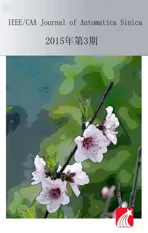Cost Minimization of Wireless Sensor Networks with Unlimited-lifetime Energy for Monitoring Oil Pipelines
2015-08-09ChangqingXiaWeiLiuandQingxuDeng
Changqing Xia,Wei Liu,and Qingxu Deng
Cost Minimization of Wireless Sensor Networks with Unlimited-lifetime Energy for Monitoring Oil Pipelines
Changqing Xia,Wei Liu,and Qingxu Deng
—Cyber-physical-system(CPS)has been widely used in both civil and military applications.Wireless sensor network (WSN)as the part and parcel of CPS faces energy problem because sensors are battery powered,which results in limited lifetime of the network.To address this energy problem,we take advantage of energy harvesting device(EHD)and study how to inde fi nitely prolong oil pipeline monitoring network lifetime by reasonable selecting EHD.Firstly,we propose a general strategy worst case-energy balance strategy(WC-EBS),which de fi nes worst case energy consumption(WCEC)as the maximum energy sensor node could expend for oil pipeline monitoring WSN.When the energy collected by EHD is equal or greater than WCEC,network can have an unlimited lifetime.However, energy harvesting rate is proportional to the price of EHD, WC-EBS will cause high network cost.To reduce network cost, we present two optimization strategies,optimization workloadenergy balance strategy(OW-EBS)and optimization fi rst nodeenergy balance strategy(OF-EBS).The main idea of OW-EBS is to cut down WCEC by reducing critical node transmission workload;OF-EBS con fi rms critical node by optimizing each sensor node transmission range,then we get the optimal energy harvesting rate in OF-EBS.The experimental results demonstrate that OF-EBS can inde fi nitely extend network lifetime with lower cost than WC-EBS and OW-EBS,and energy harvesting ratePin each strategy satis fi esfffffe
Index Terms—Cyber-physical-system(CPS),wireless sensor network(WSN),energy harvesting,cost,lifetime.
I.INTRODUCTION
E NERGY problem in WSN is becoming ever more critical and leads to some phenomena which signi fi cantly reduce network lifetime.Tremendous research work has been done to reduce the energy consumption of wireless sensor network(WSN)to extend their lifetime[1-4].However,lifetime of battery-powered WSN is limited no matter how the transmission policies or deployment strategies are optimized. To address this issue,energy harvesting device(EHD)has emerged as a promising device to prolong the operating time of WSN.EHD is a device through which sensor node can collect energy from ambient energy sources(including solar, wind,thermal and vibration)and convert it to usable electrical power to feed sensor nodes[5-7].
Fig.1 is a simple energy harvesting sensor(EHS)node, where EHD collects energy from environment.The energy isstored in a battery(or super-capacitor).Sensor node controller can adjust sensor node transmitted power and decide when to collect sensing data.Sensing data is forwarded by radio frequency(RF)circuitry[8].
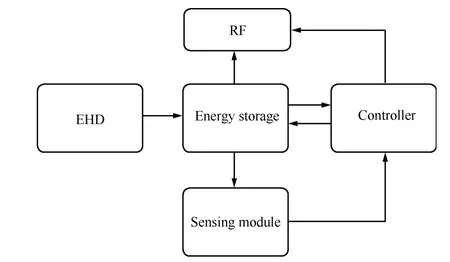
Fig.1.Structure of EHS.
As a cost effective approach for oil delivery,oil pipelines have been built in many places since oil pipelines are usually of dozens or even hundreds kilometers length.It is not realistic to real-time monitor pipeline status by human.Sensor nodes are deployed along the pipeline as a linear placement to monitor the security of oil transportation and the free fl ow of oil through the pipeline.Each node periodic collects sensing data and forwards the data to sink node by multi-hop transmission[9-10].
We have designed and implemented one node that relies on battery as shown in Fig.2.The node adopts a low power MCU MSP430 and the TI CC1101 transceiver chip.We can join different sensors to achieve different functions,i.e.,
temperature and humidity.A set of such sensor nodes have been deployed on one pipeline following the uniform distribution in Liaohe oil fi eld in China[11].However,we need high network maintenance due to the exhaustion of energy of sensor node.Since EHD can collect energy from environment, energy harvesting-wireless sensor network(EH-WSN)has emerged as an ef fi cient way to prolong network lifetime.A high energy harvesting rate EHD can extend network lifetime inde fi nitely.However,EHD price is proportional to energy harvesting rate.An exorbitant energy harvesting rate will lead to high cost and resource waste.How to guarantee network lifetime with lower network cost is a new issue we need to address.

Fig.2.The real implemented sensor.
In this paper,we consider EH-WSN for oil pipeline monitoring and study how to choose EHD to guarantee network has an unlimited life time.We fi rst propose a generalized pipeline monitoring network model.In order to ensure network lifetime,we de fi ne worst case energy consumption(WCEC)as the maximum energy sensor node could expend in one period. Based on WCEC,we present a worst case-energy balance strategy(WC-EBS)which can guarantee an unlimited network lifetime by reasonable selection of EHD.Theorem 1 has been proposed to obtain the value of WCEC.Since energy harvesting rate in WC-EBS is a pessimistic strategy,two optimization strategies optimization workload-energy balance strategy(OW-EBS)and optimization fi rst node-energy balance strategy(OF-EBS)are presented to reduce network cost based on the unlimited lifetime.Our contribution in this paper is as follows:
1)In many applications,users need to monitor the areaof-interest for a long time with a limitation on cost.In this paper,we study the problem of minimizing network cost whilst ensuring an unlimited network lifetime,which is an important issue in real applications but easy to be neglected in research.
2)We extend critical node to critical area and propose a new de fi nition of WCEC.When energy harvesting rate is equal or greater than WCEC,network can have an unlimited lifetime no matter sensory data transmits in which strategy.By analyzing energy consumption and number of transmission tasks,we can get the upper bound of WCEC.
3)By discussing the relationship among energy harvesting rate,sampling period and network scale,our methods can reduce network cost signi fi cantly with an in fi nite network lifetime.
The remainder of this paper is organized as follows:Section II provides a brief review of related work.Section III de fi nes the problem model,including WSN model for oil pipeline monitoring and energy consumption model.Section IV proposes WC-EBS to guarantee oil pipeline monitoring network has an unlimited lifetime.Section V proposes two strategies OW-EBS and OF-EBS to reduce network cost based on the unlimited network lifetime.Section VI evaluates the proposed methods by experiments,and conclusions will be given in Section VII.
II.RELATEDWORK
In many traditional applications of WSN,a large number of sensor nodes are deployed in an area to detect possible events or targets that are interesting to users.How to prolong network lifetime is a critical issue in WSN,and lots of scholars have done research on it,e.g.[2,4,11-12].However,this kind of research is based on battery powered sensor node and network has a limited lifetime.
As energy harvesting node has a renewable energy budget, some research focuses on optimization using EHD as a new approach to extend network lifetime.Techniques vary in many aspects,such as energy management,node scheduling,or routing protocol.The authors in[13]studied how to achieve closeto-optimal utility performance in energy harvesting networks with only fi nite capacity energy storage devices.They develop an energy-limited scheduling algorithm(ESA),which jointly manages the energy and makes power allocation decisions for packet transmissions.ESA only has to keep track of the amount of energy left at the network nodes and does not require any knowledge of the harvestable energy process.In [14],the authors addressed the distributed maximum lifetime coverage with energy harvesting(DMLC-EH)problem.They proposed an energy protection algorithm(MEP)that allows sensor nodes to form a minimal set cover using local information whilst minimizing missed recharging opportunities. Yang[15]proposed a myopic policy,the objective is to develop a sensing scheduling policy to ensure the expected long-term average utility generated by the sensors is maximized.
Unfortunately,even though EHD can extend network lifetime,some research focuses on the limitation of EH-WSN cost(Some researchers consider network cost problem in battery-powered sensor network or bidirectional nodes[16-18], however,these kinds of WSN cannot ensure a long network lifetime).In real applications we must consider network cost as WSN has a large number of nodes and the cost of each EHD node is more than 1.5 dollar.For this purpose,we study the problem of minimizing network cost with an unlimited lifetime in EH-WSN.
III.SYSTEMMODEL
We have the following fundamental constraints for the sensor network model.
1)There is a large number of sensor nodes.It is impractical to optimize the network on the basis of individual sensor nodes (e.g.,set a different con fi guration for each individual sensor node).
2)Each sensor node has an EHD while sink node has a continuous energy budget.As oil pipeline is built in a stable open space,we can obtain the minimum value of energy which can be collected from environment in one period.We assume this value is larger than sensor node energy harvesting rate in our system,which means energy harvesting rate of EHD is fi xed(Our system is suitable for EH-WSN with stable energy harvesting rate and has some limitations for unstable energy harvesting rate WSN);
3)Each sensor has a maximum transmission range,denoted bytx,which is smaller than the distanceLbetween two adjacent sink nodes.
4)Sensor nodes can adjust their transmission range by changing its transmission power level.
Wireless sensor network for oil pipeline monitoring is endowed with one sink node as illustrated in Fig.3.nEHS nodes are deployed along the pipeline with uniform distribution.The distance between two sensor nodes isl.Sink node is deployed at the heat station.The distance between two adjacent sink nodes isL.The number of sensor nodes isn=is sensor node transmission range,the minimum transmission range isdmin=l,l≤tx.Sensor node valid transmission range can be expressed asd=s×l,wheresis the number of transmission crossing nodes.To make sure sens¥ingƒ data could be forwarded to sink node,ssatis fi es 1

Fig.3.WSN model for oil pipeline monitoring.
Sensor nodes send sensory data to sink node by multihop transmission,each task in thei-th node chooses one node closer to sink node as the destination for data delivery.The number of transmission tasks fori-th node is denoted byki. When the transmission range of sensor nodes downstreamith node satis fi esdi+1=di+2=···=dn-1=dn,we can obtain the maximum number ofi-thnode transmission tasks, which is given by=n-i+1.
For each EHS,the energy harvesting rate isP,which is a time-invariant value.EHD collects energy all the time, energy is stored in the battery with limited capacity.Network sampling period isT,this means sensor node will collect data at everyT.Then energy collected by one node isEH=P×T.Since the rest of energy harvested by EHD will be abandoned after a full charge is reached,the optimal battery capacity isC=EH=P×T.In consideration of task forwarding time is very short and much less thanT,we ignore time slice for data forwarding.The variables are de fi ned in Table I.
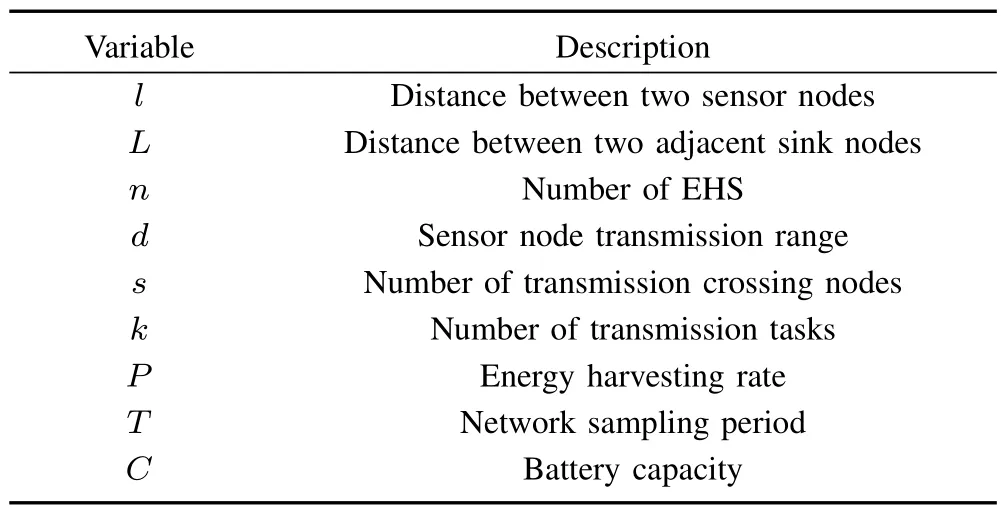
TABLE I VARIABLE DEFINITION
Sensor node energy consumption consists of two parts: the sensing and computation energy consumption,and the communication energy consumption.By[19]and[20],we can see sensing and computation energy is much smaller than communication energy consumption in real world.We can ignore the fi rst part of energy consumption and adopt the communication energy consumption model in[19]

cis a technology-dependent positive constant.αis the path loss index,the value of which depends on the transmission environment.The typical values ofαin different transmission environment are provided in Table II.As oil pipeline is built in open areas,2≤α≤4.

TABLE II PATH LOSS INDEX UNDER DIFFERENT ENVIRONMENT
IV.WORSTCASE-ENERGYBALANCESTRATEGY
In this section,we propose a worst case-energy balance strategy(WC-EBS),which guarantees oil pipeline monitoring network has an inde fi nite lifetime.The key idea is that,we estimate energy consumption of the critical node by transmission range and the number of transmission tasks.Then we select EHD to make sure sensor node worst case energy consumption is equal or less than energy harvested by EHD in one period.
A.Worst Case Energy Consumption
We de fi ne critical sensor node as the one which has the largest energy consumption in the whole network,and this energy consumption is the worst case energy consumption (WCEC)of this system.Energy consumption of critical node is different in various circumstances,the maximum one among all these circumstances is WCEC in WC-EBS.In order to determine WCEC,we need to know the factors which affect sensor node energy consumption.
Energy consumption depends on both the number of transmission tasks and transmission range,corresponding energy consumption of thei-th sensor node is

Since all sensing data is delivered to sink node via sensor nodes one hop away from sink node,energy consumption of these nodes are the bottleneck of the whole network.We call this one hop area as the critical area.By adjusting the range of critical area,we can get WCEC.When the range of critical area isl,the fi rst sensor node has the maximum transmission tasks.Forn≥1,the maximum energy consumption of the fi rst node is
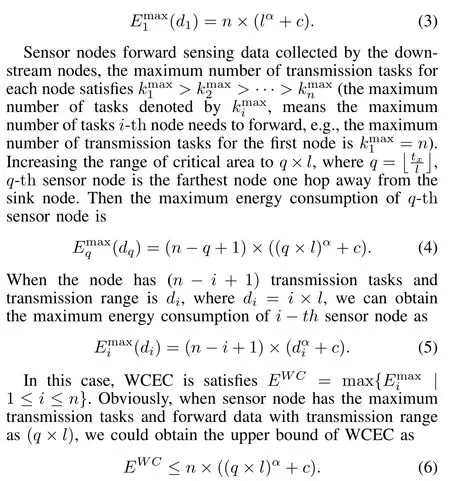
Then,we have the following theorem,
Theorem 1.For oil pipeline monitoring WSN,the sum of maximum worst case energy consumption in the critical area,and sensor node energy consumption is not larger thann×((q×l)α+c)no matter how the transmission policy is changed.
B.Balance of Energy
In this subsection,we study how to prolong network lifetime based on network WCEC.When the energy harvested by EHD in one period is equal to or greater than than WCEC, network can obtain an inde fi nite lifetime.By applying(6),EH≥EWCcan be written as

To reduce network cost,we can obtainPas

When the energy harvesting rate and the maximum transmission range is fi xed,we can adjust sampling periodTand network size to maximize EHD utilization;Similarly,we can reduce network cost by choosing the right EHD based on a given sampling periodTand network size.
V.OPTIMIZATION OFENERGYBALANCESTRATEGIES
In last section we have presented a general strategy WCEBS to prolong network lifetime based on the worst case energy consumption.WC-EBS can apply to all situations whenHowever,WC-EBS is a pessimistic strategy which generates energy waste(when energy storage is charged up to its capacity,excess harvesting energy will be wasted).The excessive energy harvesting rate will result in a high cost of network.
In this section,we propose two optimization energy balance strategy(OEBS)to reduce network cost by rationally selecting EHD.The main idea of OEBS is to minimize WCEC by optimizing critical node transmission range and transmission workload.OW-EBS and OF-EBS are presented respectively in the following.
A.OW-EBS
Network worst case energy consumption is expressed as (5),by enhancing sensor nodes transmission range outside the critical area,we can minimize critical node transmission workload.Astxis the maximum value of sensor transmission range,we can getas

To calculateEq(dq)=EH,the minimum energy harvesting rate is

With the optimal transmission workload,OW-EBS can reduce WCEC signi fi cantly.
B.OF-EBS
Since sensor node transmission range has a great in fl uence on sensor energy consumption,we propose OF-EBS to guarantee the fi rst node as the critical node by adjusting each node transmission range,meansEH=E1(d1)=max{Ei|i= 1,2,...,n}.Then energy harvesting rate is

As the node at the end of the pipeline,i.e.,n-th sensor node,only forwards sensing data collected by itself,meanskn=1,then we have
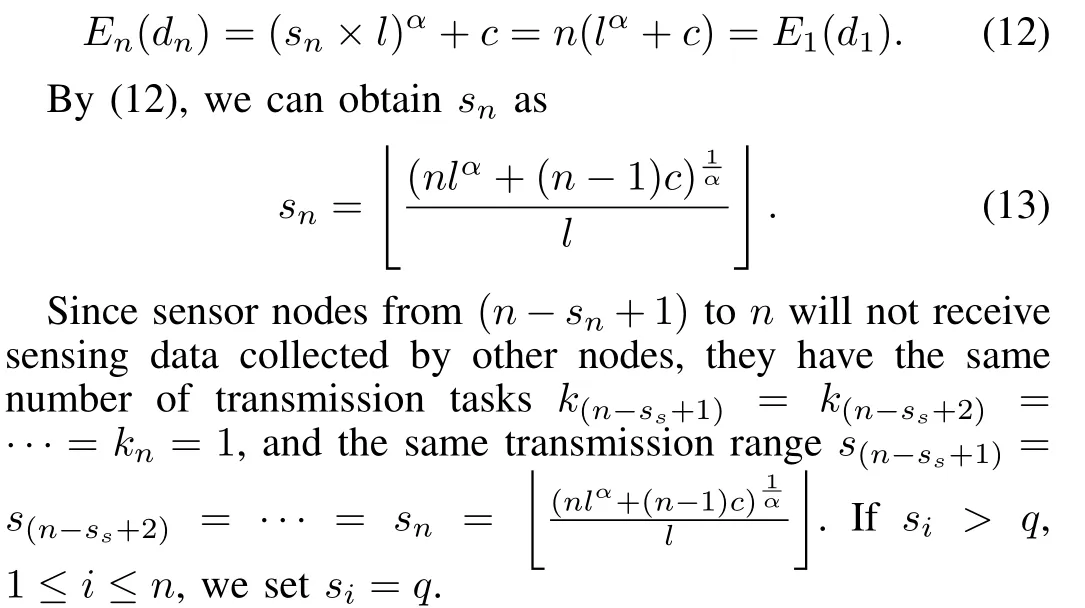
For(n-sn)-th sensor node,this node needs to forward sensing data collected by itself andn-th node,then the number of transmission tasks isk(n-sn)=kn+1=2.
It is not hard to fi nd that the transmission range and the number of network hops have a stepwise relationship,the length of each step is[1,sn-1].As Fig.4 shown,in OF-EBS, a cluster of nodes have same transmission range,the number of steps is the number of hops,number of transmission tasks of each node is equal to the step number,,andn-th node is the fi rst step.
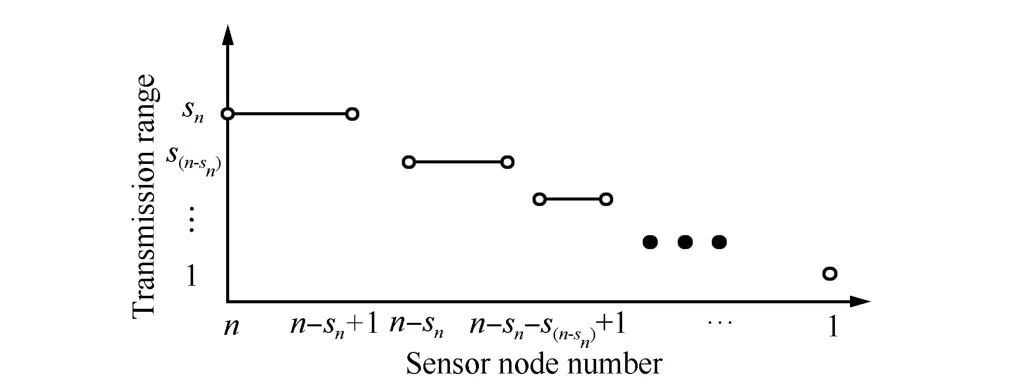
Fig.4.Relationship between transmission range and number of hops.
By determining the endpoints of the step,all sensor nodes transmission range and task workload can be obtained.Network can have an unlimited lifetime withP=
VI.COMPARISON ANDANALYSIS OFDIFFERENT STRATEGIES
In this section we compare the performance among different sensor node strategies.The comparison considers energy harvesting rate variation trend in different strategies with changing pipeline length,sampling period and the maximum transmission range,respectively.
As introduced in Section III,sensor nodes are placed along the pipeline with uniform distribution linearly.The parameter settings are as shown in Table III.

TABLE III PARAMETER SETTING
We compare the properties as variation of energy harvesting rate in different strategies.The results are in shown in Fig.5.
Fig.5(a)illustrates that,for the sameα,landT,whenLis changed from 200m to 500m,the energy harvesting rate increases withLgradually for all the strategies.WCEBS needs the biggest energy harvesting rate to guarantee energy harvested by EHD in a round is equal to the WCEC. Equation(5)shows that WCEC is decided by the number of sensor nodesnas other parameters are fi xed,n=Therefore,energy harvesting ratePchanges withLlinearly; since(n-q+1),energy harvesting rate in OW-EBS is always less than WC-EBS.Energy harvesting rate in OW-EBS changes withLas a ladder relationship,that is becauseincreases once when the additional part ofLreachestx;energy harvesting rate in OF-EBS is much lower than the other two strategies andPincreases slowly withL.The reason is critical node transmission range in OF-EBS isl,which is less thantx. Sensor node energy consumption increases with transmission range exponentially.Energy harvesting rate in OF-EBS is less than the one in OW-EBS,although number of transmission tasks in OF-EBS is more than in OW-EBS.
As Fig.5(b)shown,energy harvesting rate is inversely proportional to sampling period.When sampling periodTincreases from 0.1h to 1h with unit of 0.1h,EHD has longer time to harvest energy from environment,then energy harvesting rate reduces for all strategies.Based on the same situation, energy harvesting rate satis fi esPWC-EBS>POw-EBS>POf-EBS.That is because WCEC in the three strategies is different and satis fi esWCECWC-EBS>WCECOW-EBS>WCECOF-EBS.
The relationship of energy harvesting rate and the maximum transmission range is shown in Fig.5(c).Energy harvesting rate in WC-EBS shows exponential growth with the maximum transmission range.The reason is we decide energy harvesting rate in WC-EBS by computingP×T=n×((q×l)α+c), where;POW-EBSchanges slower thanPWC-EBS. That is because number of transmission tasks is inversely proportional to the maximum transmission range,POW-EBS has a(α-1)exponent relation totx;since the critical node energy consumption is just concerned withn,landT,energy harvesting rate in OF-EBS remain unchanged with the increase oftx.
Fig.5(d)shows the results of energy harvesting rate changes with the distance between adjacent nodes.The length of pipeline isL=500m,whenlis changed from 10m to 60m, number of sensor nodes is changed from 50 to 9.Energy harvesting rate in OW-EBS is a fi xed value and does not change whenl;in WC-EBS,energy harvesting rate reduces withlincreases,PWC-EBSis equal toPOW-EBSwhenl=tx. The reason is transmission energy consumption in both WCEBS and OW-EBS is(+c),number of transmission tasks in WC-EBS reduces withlincreases.Whenlreaches its maximum value,=kOW-EBS.Then WCEBS translates into OW-EBS;transmission range in OF-EBS is equal tol,critical node energy consumption in OF-EBS grows up with the increasing ofl.Whenl=tx,we havePOF-EBS=POW-EBS=PWC-EBS.The reason is whenl=tx,the number of transmission tasks in OW-EBS is equal to the number of tasks in the other two strategies,kOF-EBS=kOW-EBS==n.By equation (8),(10)and(11)we can getPOF-EBS=POW-EBS=PWC-EBS
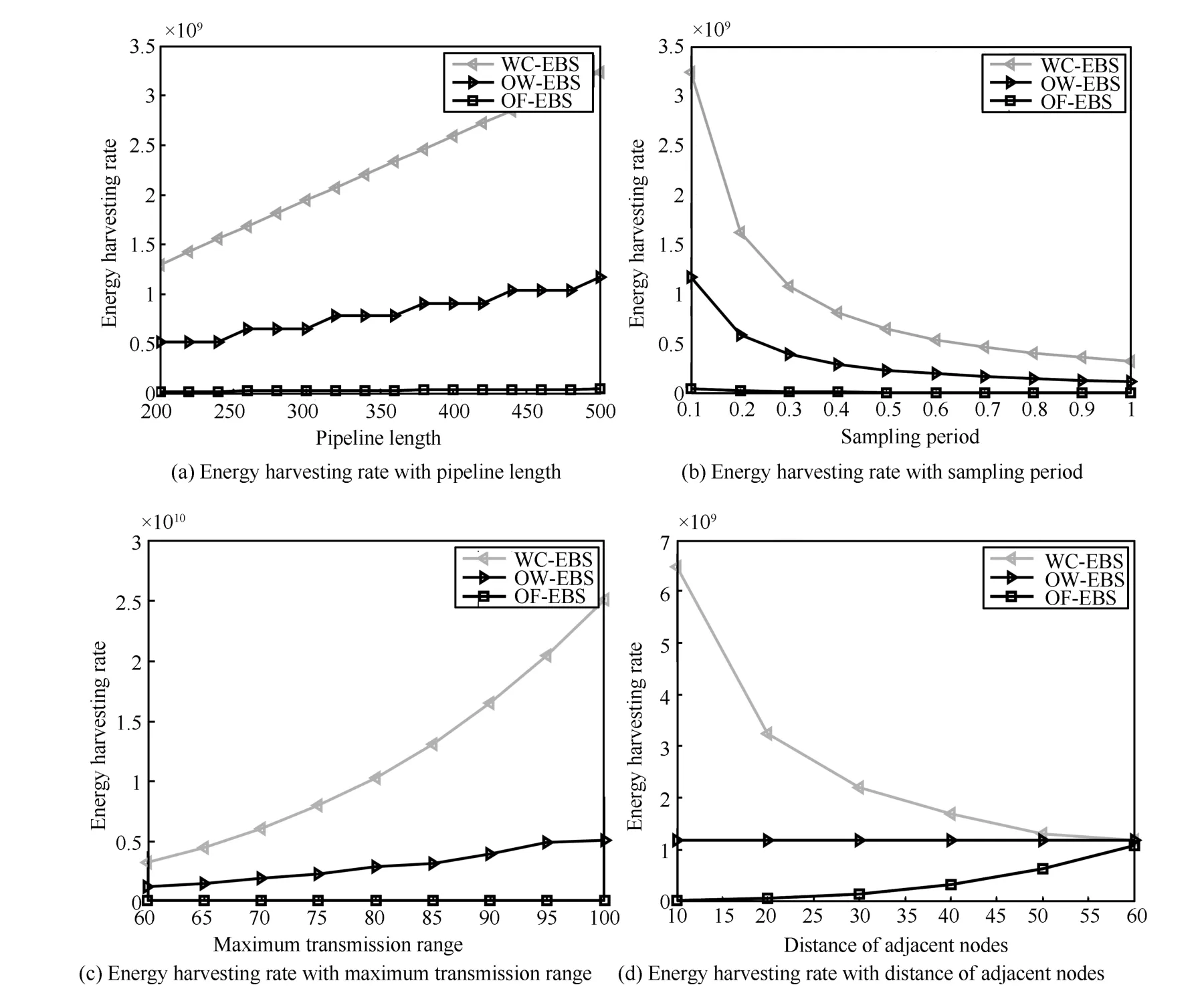
Fig.5.Energy harvesting rate plotted against various parameters.
VII.CONCLUSIONS
In this paper,we study the problem of minimizing cost of oil pipelines monitoring through reasonable selection of EHD to in fi nitely extend lifetime of WSN.We fi rst propose a general strategy WC-EBS,which de fi nes WCEC as the maximum energy expenditure which the oil pipeline monitoring sensor node can consume in one period.As an EHD choice criterion,network can have an unlimited lifetime when energy collected by EHD in one period is equal to or greater than WCEC no matter sensor nodes forward data in which strategy.Energy harvesting rate in WC-EBS can be obtained asP=.Then we present OW-EBS and OF-EBS, which reduce network WCEC by setting sensor node transmission range and optimizing number of transmission tasks.The evaluation results show that OF-EBS can inde fi nitely extend network lifetime with lower energy harvesting rate than WCEBS and OW-EBS,means network can obtain an unlimited lifetime with low cost in OF-EBS.
REFERENCES
[1]Xiong S G,Yu L,Shen H Y,Wang C,Lu W.Ef fi cient algorithms for sensor deployment and routing in sensor networks for network-structured environment monitoring.In:Proceedings of the 2012 IEEE INFOCOM. Orlando,FL:IEEE,2012.1008-1016
[2]Xia C Q,Guan N,Deng Q X,Yi W.Maximizing lifetime of threedimensional corona-based wireless sensor networks.International Journal of Distributed Sensor Networks,2014,2014:Article ID 149416
[3]Halder S,Das Bit S.Enhancement of wireless sensor network lifetime by deploying heterogeneous nodes.Journal of Network and Computer Applications,2014,38:106-124
[4]Keskin M E,Altinel K,Aras N,Ersoy C.Wireless sensor network lifetime maximization by optimal sensor deployment,activity scheduling, data routing and sink mobility.Ad Hoc Networks,2014,17:18-36
[5]Sudevalayam S,Kulkarni P.Energy harvesting sensor nodes:survey and implications.Communications Surveys&Tutorials,2011,13(3): 443-461
[6]Gunduz D,Stamatiou K,Michelusi N,Zorzi M.Designing intelligent energy harvesting communication systems.IEEE Communications Magazine,2014,52(1):210-216
[7]Dall’Ora R,Raza U,Brunelli D,Picco G P.Senseh:from simulation to deployment of energy harvesting wireless sensor networks.In:Proceedings of the 2014 IEEE Conference on Local Computer Networks Workshops(LCN Workshops).Edmonton,AB:IEEE,2014.566-573
[8]Michelusi N,Stamatiou K,Zorzi M.Transmission policies for energy harvesting sensors with time-correlated energy supply.IEEE Transactions on Communications,2013,61(7):2988-3001
[9]Broch J,Maltz D A,Johnson D B,Hu Y C,Jetcheva J.A performance comparison of multi-hop wireless ad hoc network routing protocols.In: Proceedings of the 4th Annual ACM/IEEE International Conference on Mobile Computing and Networking.New York:ACM,1998.85-97
[10]Mhatre V,Rosenberg C.Design guidelines for wireless sensor networks: communication,clustering and aggregation.Ad Hoc Networks,2004, 2(1):45-63
[11]Guo Y F,Kong F X,Zhu D K,Tosun A S,Deng Q X.Sensor placement for lifetime maximization in monitoring oil pipelines.In:Proceedings of the 1st ACM/IEEE International Conference on Cyber-Physical Systems. New York:ACM,2010.61-68
[12]Cao N,Higgs R,O′Hare G M P,Wu R.Lifetime and reliability evaluation models based on the nearest closer protocol in wireless sensor networks.In:Proceedings of the 2014 Federated Conference on Computer Science and Information Systems(FedCSIS).Warsaw:IEEE, 2014.993-1000
[13]Huang L B,Neely M J.Utility optimal scheduling in energyharvesting networks.IEEE/ACM Transactions on Networking,2013, 21(4):1117-1130
[14]Yang C L,Chin K W.A novel distributed algorithm for complete targets coverage in energy harvesting wireless sensor networks.In:Proceedings of the 2014 IEEE International Conference on Communications(ICC). Sydney,NSW:IEEE,2014.361-366
[15]Yang J.Optimal sensing scheduling in energy harvesting sensor networks.In:Proceedings of the 2014 IEEE International Conference on Communications(ICC).Sydney,NSW:IEEE,2014.4077-4082
[16]Mhatre V P,Rosenberg C,Kofman D,Mazumdar R,Shroff N.A minimum cost heterogeneous sensor network with a lifetime constraint.IEEE Transactions on Mobile Computing,2005,4(1):4-15
[17]Cheng Z,Perillo M,Heinzelman W B.General network lifetime and cost models for evaluating sensor network deployment strategies.IEEE Transactions on Mobile Computing,2008,7(4):484-497
[18]Blaszczyszyn B,Radunovi´c B.Using transmit-only sensors to reduce deployment cost of wireless sensor networks.In:Proceedings of the 27th Conference on Computer Communications.Phoenix,AZ:IEEE, 2008.1-9
[19]Olariu S,Stojmenovic I.Design guidelines for maximizing lifetime and avoiding energy holes in sensor networks with uniform distribution and uniform reporting.In:Proceedings of the 25th IEEE International Conference on Computer Communications,INFOCOM 2006.Barcelona, Spain:IEEE,2006.1-12
[20]Heinzelman W R,Chandrakasan A,Balakrishnan H.Energy-ef fi cient communication protocol for wireless microsensor networks.In:Proceedings of the 33rd Annual Hawaii International Conference on System Sciences.Maui,HI,USA:IEEE,2000.1-10
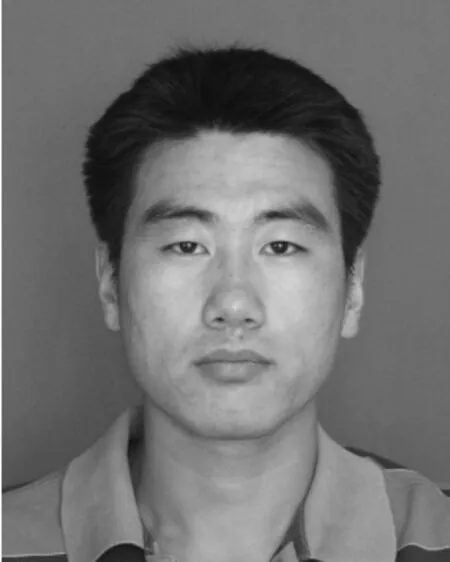
Changqing Xia Ph.D.candidate at the Institute of Cyber Physical Systems Engineering,Northeastern University,China.His research interests include wireless-sensor-network routing design and sensor deployment in real environments,performance and power-performance-reliability trade-off.
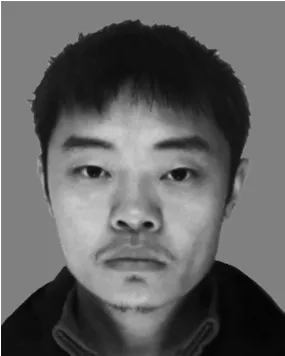
Wei Liu Ph.D.candidate in computer science at Technical University of Dortmund,Germany.His main research interest is cyber-physical systems.

ng
the Ph.D.degree in computer science from Northeastern University,China in 1997.He is a professor at the College of Information Science and Engineering,Northeastern University, China,where he serves as the director of institute of Cyber Physical Systems Engineering.Starting from 2010,he is also the director of the Key Laboratory of Embedded Systems of Liaoning Province.His research interests include cyber-physical systems, embedded systems,and real-time systems.
Manuscript received September 30,2014;accepted May 17,2015.This work is partially supported by National Natural Science Foundation of China(61472072)and National Basic Pre-research Program of China (2014CB360509).Recommended by Associate Editor Jiming Chen.
:Changqing Xia,Wei Liu,Qingxu Deng.Cost minimization of wireless sensor networks with unlimited-lifetime energy for monitoring oil pipelines.IEEE/CAA Journal of Automatica Sinica,2015,2(3):290-295 (e-mail:@foxmail.com).
Changqing Xia is with Northeastern University,Shenyang 110819,China
Wei Liu is with Technical University of Dortmund,Dortmund 44221, Germany(e-mail:liuwei-neu@hotmail.com).
Qingxu Deng is with Northeastern University,Shenyang 110819,China (e-mail:dengqx@mail.neu.edu.cn).
He is a senior member of China Computer Federation and member of IEEE and ACM.He has served as the TPC member of many conferences such as DAC,ASP-DAC,RTCSA and so on.His papers are published in conferences as RTSS,DAC,DATE,and journals like IEEE Trans.and ACM Trans.He received the second prize of National Scienti fi c and Technological Progress Award in 2014,the fi rst prize of Technological Innovation Award of Liaoning Province in 2013,the second prize of Scienti fi c and Technological Progress Award of Liaoning Province in 2014.
杂志排行
IEEE/CAA Journal of Automatica Sinica的其它文章
- End-to-end Delay Analysis for Mixed-criticality WirelessHART Networks
- An Algebraic Detection Approach for Control Systems under Multiple Stochastic Cyber-attacks
- A Stochastic Programming Strategy in Microgrid Cyber Physical Energy System for Energy Optimal Operation
- Distributed Secondary Control and Optimal Power Sharing in Microgrids
- Water Supply Networks as Cyber-physical Systems and Controllability Analysis
- Guest Editorial for Special Issue on Cyber-Physical Systems
